Dzaipi LRA Massacre: Dzaipi sub county, Adjumani District.
Dzaipi trading center is located 27 km east of Adjumani town in Adjumani District. When the Lords’ Resistance Army attacked Dzaipi and killed a total of 8 civilians on the 8th of March 2005, it was the very first time the Lord’s Resistance Army had come there. A witnesses from Dzaipi narrates that the day before the attack Dzaipi was very peaceful. And that in the same year, Dzaipi center was selected by the District Authority to host the celebration of the International Women’s’ Day. During the day, the celebration was going on smoothly as people enjoyed and jubilated. Yet in the midst of the party mood villagers noticed strangers drinking and dancing with them.
The situation changed abruptly late in the night when the LRA attacked. As a witness named Alfred narrated:
“We were seated down here (pointing to his house) and we saw fire burning at the center, because we were neighbors, immediately I rushed to wake him up, in just about three minutes before reaching his house was surrounded by the rebels. I heard bullets fired, the 1st in the air then very many into the house where my brother and the family was. My brother was shot in the knee, the wife in the jaw, and the child in the hand and later my brother died of the injury”,
Four of those killed were women and about 78 huts were burnt and properties were looted. Those who survived with injuries were taken to Adjumani hospital and those with critical condition were rushed to Lacor Hospital in Gulu District to save their lives. In response to the tragedy, the Government of Uganda under the Adjumani disaster preparedness committee provided some food rations which included posho and beans and blankets for affected families. But this was insufficient. Family members got 5kgs of posho, 2kgs of beans, and people had to find means of getting other resources for survival because they had already lost everything in the looting
The massacre greatly disrupted the socio-economic livelihood of very many villagers, which in turn directly impacted on schooling for children.
“It was the first time that this happened and it made people to feel very bad and most of us had to flee our homes and seek refuge in Internally Displaced Camps (IDPs), others ran to their relatives in Gulu town. The killing took place in an open space and these people were attacked on their way back home after the celebration. That ground was the killing site. The 8 who were killed were buried some 2 kilometers from the killing site at Dzaipi mission burial site. Surprisingly, there was a small detach call Okuleago (small barracks) not more than 2 kilometers from the massacre site. But because they were few in number, the Uganda People Defense Forces (UPDF) could not respond immediately, and they waited until dawn. This made the civilians to feel bad and some decided to leave their homes including me, I left for 5years”, An eye witness account.
Life upon return was not easy because many still lived with trauma and had to start a new life. To date, the LRA soldiers who are commonly called or known as “Acholi” have left a set of deep and untreated wounds and injuries in the minds and the heart of the community of Dzaipi.
On 8th of March 2005, the LRA of unknown number attacked Dzaipi sub-county headquarter that had on the previous day held its annual commemoration of women’s day. According to survivors, they had started witnessing strange non uniformed and a few uniformed soldiers not at least from Dzaipi barracks but yet continued dancing together till morning. Prior to the attack, the LRA had through one community member delivered a letter announcing the intent to attack Dzaipi. Though the notice reached a small army barracks with had about 30 soldiers under the command of Abiriga, it was not given serious attention. Early alert threats through letter was noticeable strategy of LRA brutal massacre across northern Uganda evidence in Mucwini, and Pajule.
GPS Location Dzaipi LRA Massacre (N03.39705, E031.95579), Elva 710m Dzaipi Center, killing site
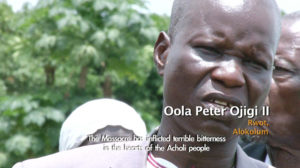 In summary: On the 19th of May 2004, the Lord’s Resistance Army (LRA) raided the village of Lukodi, and carried out a massacre that led to the death of over sixty people. Lukodi village is located seventeen kilometres north of Gulu town, in Gulu district. It is one of the many villages in northern Uganda that suffered from persistent LRA attacks, leading to the death of several people. Northern Uganda has been under conflict for over twenty years, as a result of a civil war waged mainly between the rebels of the LRA and the Government of Uganda (GoU). The impacts of the conflict have been devastating, characterised by the displacement of over 1.8 million people into IDP camps, loss of lives, and abduction of over 38,000 children by the LRA to serve as child soldiers and sex slaves. Lukodi, like many other villages in northern Uganda, was severely affected by the conflict, leading to the displacement of the inhabitants of the village who were forced to seek refuge in the congested camp of Coope for three years. The people of Lukodi were able to begin returning to their homes as a result of the relative peace which ensued in northern Uganda after the conclusion of the Juba peace talks in November 2008.
In summary: On the 19th of May 2004, the Lord’s Resistance Army (LRA) raided the village of Lukodi, and carried out a massacre that led to the death of over sixty people. Lukodi village is located seventeen kilometres north of Gulu town, in Gulu district. It is one of the many villages in northern Uganda that suffered from persistent LRA attacks, leading to the death of several people. Northern Uganda has been under conflict for over twenty years, as a result of a civil war waged mainly between the rebels of the LRA and the Government of Uganda (GoU). The impacts of the conflict have been devastating, characterised by the displacement of over 1.8 million people into IDP camps, loss of lives, and abduction of over 38,000 children by the LRA to serve as child soldiers and sex slaves. Lukodi, like many other villages in northern Uganda, was severely affected by the conflict, leading to the displacement of the inhabitants of the village who were forced to seek refuge in the congested camp of Coope for three years. The people of Lukodi were able to begin returning to their homes as a result of the relative peace which ensued in northern Uganda after the conclusion of the Juba peace talks in November 2008.
More Articles and video links to the massacre bellow;
During a five-day spell, between April 14 and 18, 1991, the village which lies 16 kilometres northeast of Gulu town was turned upside down by NRA soldiers from the 22nd Battalion which was commanded by Major Reuben Ikondere under the auspices of Operation North, whose overall commander was the then Maj Gen David Tinyefuza.
A media article covering the incident is available here.
At least 35 men were placed in a hole on the ground and 5 died immediately. the number that died after the incident is still unknown. According to those I spoke to, Villagers were suffocated by burning peper and directing the smoke to the people pilled in the hole. It was just three years ago that groups of civil society organisation together with community constructed a monument to remember the killing. while an official apology has been given by government, the community’s request for monument was answered by CSOs. what still pending is the issue of compensation that needs to happen.
NRA (National Resistance Army) Massacre of 45
In the earlier attainment of power, soldiers of the NRA wouldn’t settle for news of rebel collaborators. In Lobolatek, it started as rumours that one village man was a rebel fighter and had in his possession a gun. Locals knew him very well. Time and again he would return to their home and stayed with his people shortly before he furnishes into the thick bushes. according to family members and community around the memorial, news about the rebel fighter somehow reached the NRA. on this fateful day, a group of the soldiers came and surrounded the entire village, arresting and torturing people as the moved along with. Pregnant mothers, children and elderly were spared by sending them away. the 45 killed were those gathered from around the villages and were accused of hiding amidst them a rebel who had guns. And that according to local residents were the motives for the massacre.
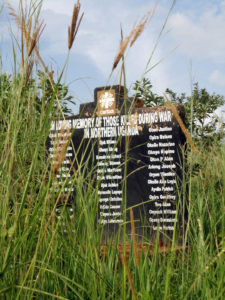 A monument constructed in memory of those killed in this place. Commonly known as Lobo Latek, in Latany Sub county, Dure parish, Pader district
A monument constructed in memory of those killed in this place. Commonly known as Lobo Latek, in Latany Sub county, Dure parish, Pader district
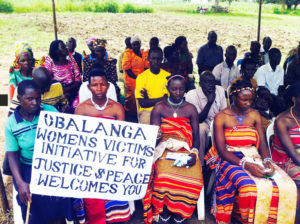
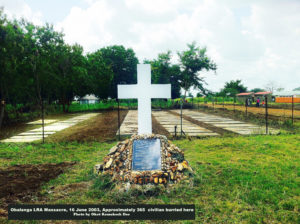
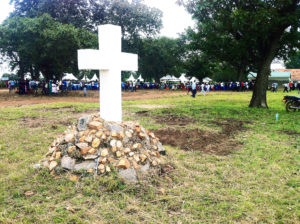
Author: Okot komakech Deo
The infiltration of LRA into Teso Region left a legacy whose story is yet to be told. Obalanga is one Amurias district sub county Teso sub-region in eastern Uganda Amuria is a town in the Eastern Region of Uganda. In June 2003, the LRA infiltrated Teso sub-region in eastern Uganda for the first time. The civilian population and the government army were caught unaware, a factor which had disastrous humanitarian implications. The first village that fell victim to the LRA attacks was Angica A village in Alito Parish, 30 kilometers north of Obalanga. In line with their trademark pattern of atrocities, the rebel soldiers carried out killings, abductions, maiming, looting, rape burning and pillaging. By the time the UPDF repulsed them almost 8 months later, approximately 90% of the population in Teso sub-region had been displaced into internally displaced persons (IDP) camps, several thousand children had been abducted and thousands of people had lost their lives and property. Obalanga sub ‐ county is located about 27 kilometers north of Amuria town and is one of the sub ‐ counties that was arguably most affected by the LRA incursion. Given its location on the border with Lango sub ‐ region, it was used as strategic point of entry for the LRA. The sub-county headquarters later became the largest IDP camp in Teso sub‐ region, sheltering over 40,000 internally displaced persons. Obalanga is also home to one of the largest mass graves in Teso, with approximately 365 remains of victims buried in it.
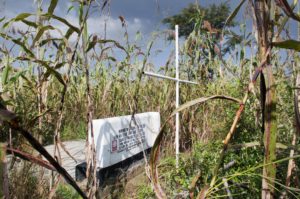
Pella Wicere, Uganda – December 5: Memorial for victims of crossfire between LRA and UPDF on 2 January 2003. 18 people buried here, believed to be abductees. Others buried elsewhere. Pella Wicere village, Omiyanyima Sub-county, Kitgum district December 5 2011
The battle/ clashes between the LRA and UPDF on 02, Jan 2003 left over 18 people dead in the village of Pella Wicere, Omiyanyima Sub-county, Kitgum district.
The community of Agora village depends on an aged withered tree to remember this spot of the ambush .
A group of LRA rebels followed their gun to a village of Pubec.
21st February, 2014 Barlonyo LRA Massacre, Lira District
LRA Rebel leader Odyambo Commanded the attack on the IDP- Internally Displaced Person. Victims bodies where buried in trances of the local Militia “Amuku” local defence. The exact number of victims today has not yet been established. The memorial in-place as it stands has numbered the killings to 350. Family members, survivors and residents of Barlonyo are not in support of the government constructed monument and continues to question the numbers engraved on it. Barlonyo victims continue to hold memorial prayers yearly with support from refugee Law project and other stakeholders
Tony from Barlonyo; During 2004, I was General Secretary of Barlonyo IDP camp. Its 24 kms north east of Lira town. Now during that time when this massacre happened on 21 September, 2004 on Saturday around 5:44pm when these LRA arrived from the eastern part of Barlonyo camp. Now during that time there were local militia were about 49, and some were killed during that massacre. During that time the house holds were 479 in IDP camp. Now the bombs they were using were very complicated, they were using recoilless bombs, RPG and others. Those who were killed there were beaten, shot and some died in hut inside with fire burning under command of Okot Odhiambo. The Amuka commander was Olunga Fred. The number of people killed were 301 and this the list submitted. The number of people admitted Lira hospital where 49, and one child 3 month named Fiona was taken to Gulu family home so number remaining 47.
Barlonyo as I saw on list was in Ogur Sub County and now is in Agweng sub county Orit parish, in Lira district.
Now this number of these people who were killed we counted physically because there one army commander called Ondoga who mistreated those who escaped, and by the time of coming he had made the army to destroy some huts to hide some people. Then at that time there were two MPs, Oryetmoi from Erute north and MP for Alebtong plus the police who came there in the morning of the following day Sunday. Now these people some were killed at pit latrine being dug around the camp.
Now from there these people were counted and then buried in army trench around the put in kavera and placed along the trench. And some of them, their relatives took them at their respective home to bury. Now some of these people at the Lira Referral hospital some of them died, so now as I talk some of them have died because had wounds. The good thing we have is Action Aid and Ayinet is working with the people to remove the bullets from those who got this incidence.
Now what I have seen for this sitting it can remind us to see what is good and what is bad for us to victims or those who were traumatised. Now as I talk, various NGOs working trying to counsel affected people. Now as I talk people are becoming better, we have religious and traditional leaders who been talking to our people. Now the attitude has started changing. Even though when you go there you will see that the Trading Centre is developing very fast.
We asked for Agro technical school has been given by president and we have Kaguta bridge has been build and that is our achievement.
Grisly pictures of the massacre of 28 residents of Gang Pa Aculu trading Centre,
On October 23rd 2002, an estimated forty-four fighters of the Lord’s Resistance Army (LRA) entered Omot Sub County from Par Samuelo Acak, near the river Agogo. They were given instruction by their LRA Commander, as soon as we cross the river, abduct whoever you come across until we reach Corner Gang pa Aculu in Opota Trading Centre.The team, consisting mostly of young soldiers, first moved North East, abducting twelve people in Lawal Ode, an additional eight people in Lalur Onyol and finally another twelve people were abducted from Latin Ling before they reached the point of slaughter. The Opota Trading Centre at Corner Gang Pa Aculu was the site where twenty-eight people lost their lives in the brutal and dehumanising Omot massacre. People were murdered, cut into pieces and then placed in cooking pots in front of dozens of witnesses.
The rebels chopped some of their victims into pieces and stuffed the body parts into a big black pot, to be cooked in the middle of a road at the trading centre.
Local sub-county leaders identified the victims. The incident was reported by Ugandan newspaper (The New Vision) as a punishment to the villagers for allowing a captive to escape through their village with some valuables belonging to the rebels.The rebels struck, asking the villagers the whereabouts of one of their fighters only identified as Ogong who had allegedly escaped with a gun, a large sum of money and a Polaroid camera. The rebels had just lost a battle to the UPDF in Pader. In their attempt to trace the fugitive, the rebels rounded up eight men and 20 women from Lawol Oder village, where the man was said to be hiding. After failing to get the runaway, the rebels turned their vengeance on the villagers. A horrified witness, who feared to be named, narrated how the rebels tied the victims kandoya-style (hands tied tightly at the elbows from the back), using sisal ropes. The victims were herded to Gang Pa Aculu village where they were executed in the middle of the road. After the massacre, the rebels then set a huge pot on three stones, chopped off the victims heads and limbs and stuffed the parts in the pot. Fortunately, the UPDF arrived at the scene in armoured vehicles and dispersed the rebels.
The local leaders identified two victims, Okidi Doctor and Ochan Lomoi, whose parts were stuffed in the pot. Other captives reportedly waited for execution in turns while others were told to eat roasted human flesh. Other victims were Martin Ocii, Alphonse Econg, Dennis Nyuta, a teacher at St Charles Lwanga, Kalongo and Okello Otwoli, who was roasted and placed on a dish.
Others were Kastorio Ogwal, Nyeko Aguda, Philimeto Okech, Christine Abiya, Cantina Alanyo, Andrew Kiwel and Night Oali, all from Bar Otiba and Patongo sub-counties.
“All men were expected to carry along a specifically design identification card and who ever didn’t have it at one moment risked being killed and in this fashion many lost their lives”
Kulu Gaal Massacre
Details pending
Details pending.
Details pending

Abduction, Attack

Attack

Attack

Attack

Abduction, Attack

Attack

Attack

Attack
Attack

Attack

Attack

Attack
Attack
Attack
Attack
Attack
Attack
Attack
